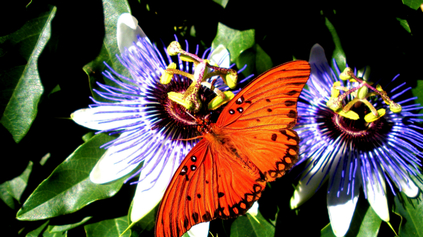The triple curled parsley that I planted last fall has now reached a
height of three and a half feet and has hundreds of beautiful blooms.
And busy eating the foliage is the caterpillar or larvae for the black
swallowtail butterfly.
Soon these multi-colored caterpillars will find a quiet place to form
a chrysalis and begin their metamorphosis into adult butterflies.
Plants such as the triple curled parsley are a food source for the larvae
stage of butterflies. They are called ‘host’ plants. By planting the
right hosts, you can attract the types of butterflies that you would
like to see in your garden.
For black swallowtails, the curled and flat-leaf (Italian) parsleys
work well. The butterflies seem to track them down, even if I have
them growing in pots in the greenhouse.
Other host plants for this butterfly species are dill, fennel, and rue
(Ruta graveolens). For monarch and queen butterflies, try planting
butterfly weed (Asclepias tuberose). This tropical milkweed grows
to a height of 2 to 4 feet, and has beautiful orange and red flowers.
Besides being a host plant, milkweed also attracts butterflies be-
cause of its abundance of nectar. Nectar plants act as fueling stations
or pit stops for many different species.
Other great nectar plants commonly found in our central Texas
gardens are lantanas, butterfly bushes (Buddlea), pentas, mist-
flowers (Eupatoriums), mealy sages, Turk’s caps, and wild berga-
mot.
The list of host and nectar plants is long and includes many native
and adaptive species that thrive in our region with little care. Many
add beauty with water conservation in mind. The Native Plant Soc-
iety of Texas offers a complete list on their website: host plants
Why not add a few of these drought-hardy species to your garden
and be a good Lepidopteral host to these marvels of nature.
Happy butterfly gardening!
____________________________________________________
Salsa Asado -- Fire-Grilled Salsa
by Mick Vann Makes about 1 quart
2 pounds ripe tomatoes
4 scallions, trimmed
6 cloves garlic, whole, peeled
6 large serrano chiles, stemmed
2 to 3 dried chipotle chiles
1 tablespoon fresh lime juice
1 tablespoon olive oil
¼ cup minced cilantro
Chicken stock for thinning
Salt, to taste
Pinch of sugar, to taste
____________________________________________________
1. Build a fire and using a grill basket, cook the tomatoes until hot,
softened, and moderately charred (about 12 to 15 minutes, depending
on the heat level). Remove the stems; reserve. Add the scallions,
garlic, and serranos to the basket and moderately char their exteriors
in the basket, turning or tossing frequently. Add to the tomatoes.
____________________________________________________
2. Using a pair of tongs or the grill basket, toast the chipotles over
the fire briefly until they soften, puff up, and become fragrant (do
not burn them, as they will get bitter). Cut off the stem and shake
out most of the seeds. Add the dried chiles and lime juice to the
reserved ingredients.
____________________________________________________
3. Place all of the ingredients into a mortar and pestle (molcajete)
and grind to produce a slightly chunky salsa; alternatively, pulse in
a food processor or pulse in a blander to reach a slightly chunky
consistency.
____________________________________________________
4. Heat a large non-stick sauté pan over medium-high heat and swirl
in the olive oil. Add the salsa to the skillet and sauté the sauce over
medium heat while stirring occasionally with a wooden spoon for
about 5 to 7 minutes, or until slightly thickened. Add a little chicken
stock if you want the sauce thinner. Season to taste with salt and a
pinch of sugar. Once it has cooled to room temperature, stir in the
cilantro.
____________________________________________________
Note:
You can also char all of the ingredients under the broiler in a foil-lined
roasting pan; the tomatoes will take longer to cook than the other ingre-
dients, so start with them separately. You can serve the sauce uncooked
if you prefer, but sautéing the sauce will add to the complexity of the
flavor. Three to six jalapeños can be substituted for the serranos. Three
dried guajillo chiles and 6 dried chile de árbol chiles can be substituted
for the chipotles (or used in combination with the chipotles for extra
spiciness). You can also dry-toast the chiles in a dry skillet or comal,
on the stove.
____________________________________________________
A big thank you to Mick for sharing his recipes with us. Read more


 Visit the website:
Visit the website: